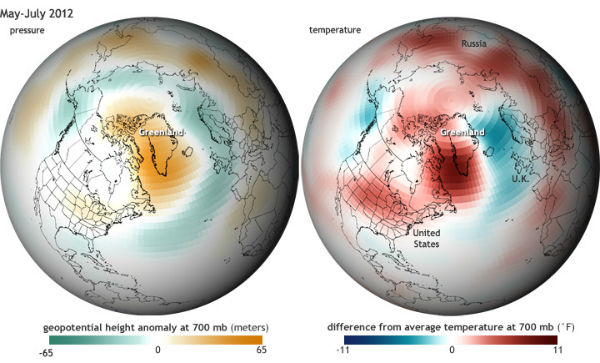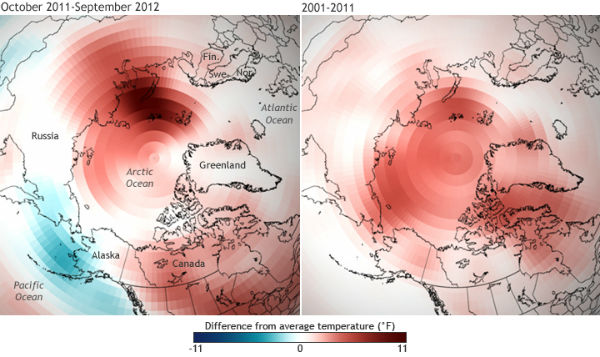

| Visitors Now: | |
| Total Visits: | |
| Total Stories: |
2012 Arctic Report Card – Dramatic changes in the Arctic
The Arctic Report Card is tracking recent environmental changes, with 20 essays on different aspects of the environment. The Arctic Report Cards produced by the National Oceanic and Atmospheric Administration (NOAA) are a source of reliable and brief information on the current state of the Arctic environment. It is created by an international team of 141 scientists from 15 different countries, with an independent peer-review organized by the Arctic Monitoring and Assessment Programme of the Arctic Council.
The Arctic Report Card considers a wide range of environmental observations throughout the Arctic, and is updated annually. A major finding of the Report Card 2012 is that numerous record-setting melting events occurred through Arctic. New records were set for sea ice extent, terrestrial snow extent, melting at the surface of the Greenland ice sheet, and permafrost temperature. Scientists point that it is very likely that major changes will continue to occur in the Arctic in years to come, particularly in the face of projections that indicate continued global warming.
Major findings of this year’s report- Record low snow extent and low sea ice extent occurred in June and September, respectively. A new record low snow extent for the Northern Hemisphere was set in June 2012, and a new record low was reached in May over Eurasia.
- Growing season length is increasing along with tundra greenness and above-ground biomass. Below the tundra, record high permafrost temperatures occurred in northernmost Alaska. The tundra is getting greener and there’s more above-ground growth. During the period of 2003-2010, the length of the growing season increased through much of the Arctic.
- Duration of melting was the longest observed yet on the Greenland ice sheet, and a rare, nearly ice sheet-wide melt event occurred in July. Minimum Arctic sea ice extent in September 2012 set a new all-time record low, as measured by satellite since 1979. There was a rare, nearly ice sheet-wide melt event on the Greenland ice sheet in July, covering about 97 percent of the ice sheet on a single day.
- Sea surface temperatures in summer continue to be warmer than the long-term average at the growing ice-free margins, while upper ocean temperature and salinity show significant interannual variability with no clear trends.
- Massive phytoplankton blooms below summer sea ice suggest previous estimates of ocean primary productivity might be ten times too low.
- Arctic fox is close to extinction in Fennoscandia and vulnerable to further changes in the lemming cycle and the encroaching Red fox.
- Severe weather events included extreme cold and snowfall in Eurasia, and two major storms with deep central pressure and strong winds offshore of western and northern Alaska.
The impacts of a persistent warming trend began over 30 years ago and its seriously affecting climate and ecosystems. Changes in the sea ice cover, snow cover, glaciers and Greenland ice sheet all conspire to reduce the overall surface reflectivity of the region in the summer, when the sun is ever-present, meaning that bright, white surfaces that reflect summer sunlight are being replaced by darker surfaces like ocean and land, which absorb sunlight. These conditions increase the capacity to store heat within the Arctic system, which enables more melting – a positive feedback.
A second key point in Report Card 2012 is that changes in the Arctic marine environment are affecting the foundation of the food web in both the terrestrial and marine ecosystems. While more difficult to discern, there are also observations that confirm the inevitable impacts these changes have on a wide range of higher-trophic Arctic and migratory species. Motivated by these linkages and the record-setting environmental changes in the Arctic region, a number of new programs are underway to more effectively measure, monitor and document changes in the marine and terrestrial ecosystems.

Geopotential height pressure and temperature anomaly over Greenland in May – July 2012 period (Credit: Dan Pisut/NOAA/ESRL Physical Sciences Division)
Surface temperatures in the Arctic were much warmer than average for the first decade of the 21st century. Highlights of the Report Card along with other visualizations can be found on Climate.gov.
Conservation of Arctic Flora and Fauna’s (CAFF)
Circumpolar Biodiversity Monitoring Programme (CBMP)
Protection of the Arctic Marine Environment
Arctic Contaminants Action Program
Air Temperature, Atmospheric Circulation and Clouds
Sources: NOAA, ClimateWatch
Featured image: Shallow melt ponds on the surface of the consolidated sea ice pack in the Chukchi Sea in July 2011 (Courtesy Karen Frey/Clark University)
2012 Arctic Report Card – Dramatic changes in the Arctic
Related posts:
- Arctic sea ice at lowest level on record The amount of sea ice in the Arctic has fallen...
- Arctic sea ice shrinks to smallest extent ever recorded Rate of summer ice melt smashes two previous record lows...
2012-12-07 11:20:50
Source: http://thewatchers.adorraeli.com/2012/12/07/2012-arctic-report-card/
Source:




